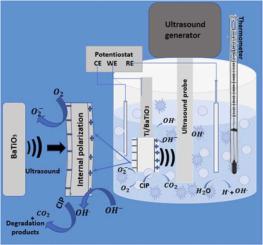Journal of Environmental Chemical Engineering ( IF 7.4 ) Pub Date : 2022-01-18 , DOI: 10.1016/j.jece.2022.107224 Babatope O. Ojo 1 , Omotayo A. Arotiba 1, 2 , Nonhlangabezo Mabuba 1, 2

|
We report the sonoelectrochemical degradation of ciprofloxacin in water using BaTiO3 supported on a titanium sheet electrode (Ti/BaTiO3). BaTiO3 nanoparticle was synthesized and characterized with X-ray diffractometer (XRD), field emission scanning electron microscopy (FESEM) and energy-dispersive X-ray spectrometer (EDS). Ti/BaTiO3 electrode was fabricated by drop-drying a slurry of BaTiO3 on an etched titanium sheet. Electrochemical techniques such as cyclic voltammetry (CV), chronoamperometry (CA), linear sweep voltammetry (LSV) and electrochemical impedance spectroscopy (EIS) were used to determine the current response as a function of the induced polarization within the BaTiO3 crystal. The sonocurrent response of the electrode was improved and the impedance was lowered as the applied ultrasound power was increased from 20 W to 40 W. The application of the fabricated electrode for sonoelectrochemical (SEC) degradation of ciprofloxacin in synthetic and real wastewater samples were carried out for 180 min. A degradation efficiency of 68.42% was at 40 W ultrasound power, 2.0 V bias potential and 10 mm electrode-probe distance. Furthermore, the mineralization percentages of 49.63% and 30.74% were obtained for total organic carbon removal in synthetic wastewater and real wastewater, respectively. A positive synergy obtained reveals that Ti/BaTiO3 electrode is effective and suitable for sonoelectrochemical removal of pharmaceutical pollutants in water.
中文翻译:

Ti/BaTiO3电极对水中环丙沙星的声电化学降解
我们报告了使用负载在钛片电极(Ti/BaTiO 3)上的 BaTiO 3对水中的环丙沙星进行声电化学降解。合成了BaTiO 3纳米颗粒,并采用X射线衍射仪(XRD)、场发射扫描电子显微镜(FESEM)和能量色散X射线光谱仪(EDS)对其进行了表征。Ti/BaTiO 3电极是通过在蚀刻的钛片上滴干BaTiO 3浆液来制造的。电化学技术如循环伏安法 (CV)、计时电流法 (CA)、线性扫描伏安法 (LSV) 和电化学阻抗谱 (EIS) 用于确定电流响应与 BaTiO 3内的感应极化的函数关系水晶。随着施加的超声功率从 20 W 增加到 40 W,电极的声电流响应得到改善,阻抗降低。在合成和真实废水样品中,将制备的电极应用于环丙沙星的声电化学 (SEC) 降解。 180 分钟。在 40 W 超声功率、2.0 V 偏置电位和 10 mm 电极-探针距离下,降解效率为 68.42%。此外,合成废水和实际废水中的总有机碳去除率分别为 49.63% 和 30.74%。获得的正协同作用表明 Ti/BaTiO 3 电极适用于水中药物污染物的声电化学去除。











































 京公网安备 11010802027423号
京公网安备 11010802027423号